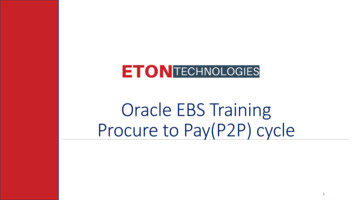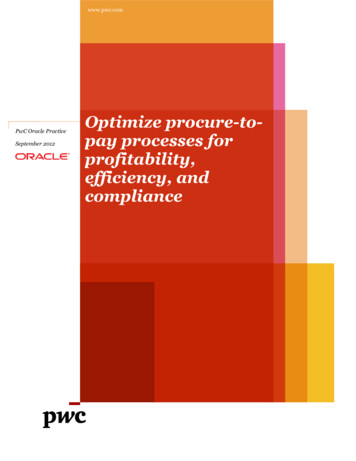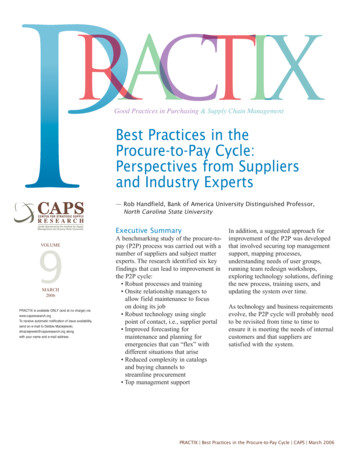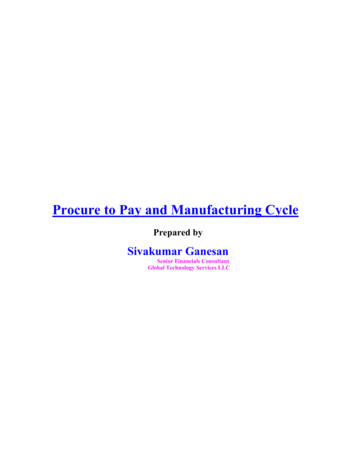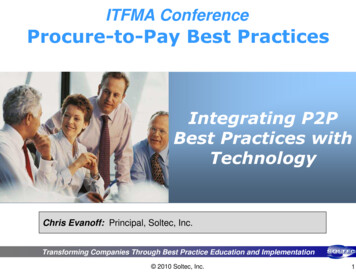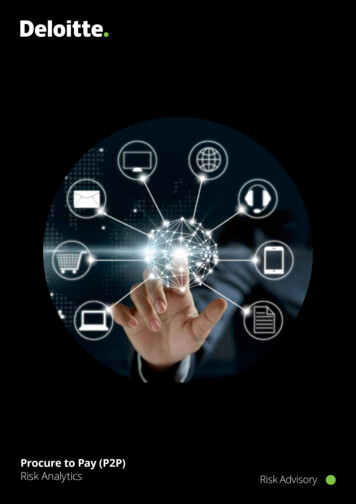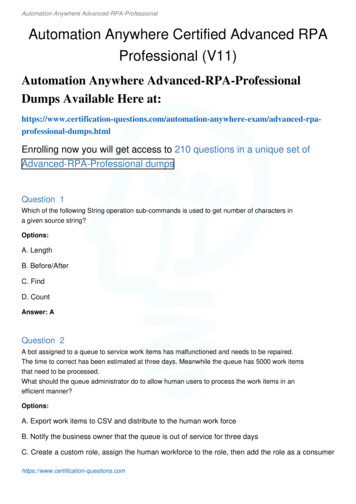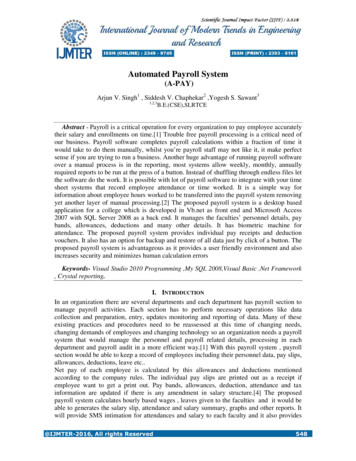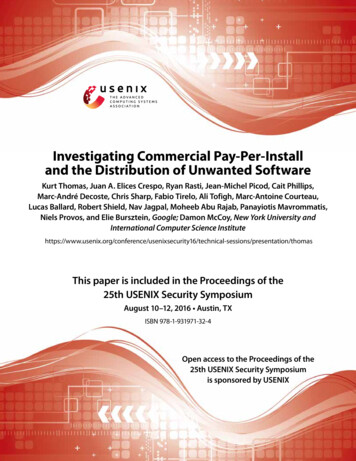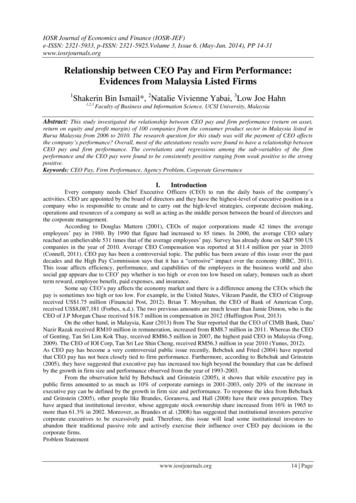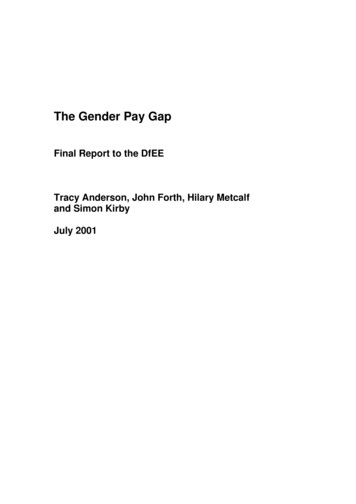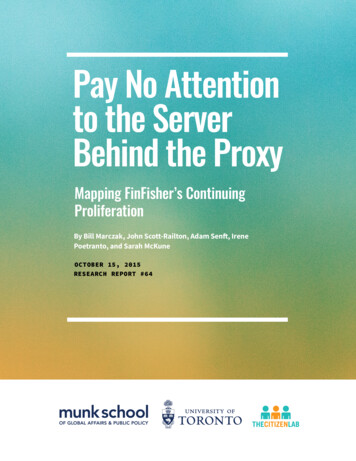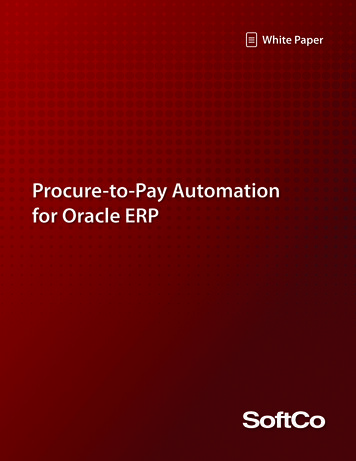
Transcription
Procure-to-Pay Automationfor Oracle ERP
ContentsExecutive Summary.2Introduction.3Drivers for integrating procure-to-pay automation with Oracle.4The case for procure-to-pay automation.5How does SoftCo Procure-to-Pay work?.7Implementing & integrating SoftCo Procure-to-Pay with Oracle.9SoftCo Procure-to-Pay - Oracle integration methods.10Case Studies.12Conclusion.13About SoftCo.141
Executive SummaryAccording to research from Deloitte, a top priority for 75% of finance leaders is to reduce costs. In order to improveprofitability, more than 80% of finance leaders plan to implement productivity and efficiency improvement initiatives.As a result, an increasing number look to modernize their procure-to-pay (P2P) processes.Automation of financial processes is no longer an optional step for organizations – it is essential for high performance.Many organizations automate their financial processes and integrate with existing ERPs and core accountingsystems. These integrations promote efficiency and improve bottom-line performance. This white paper details theexponential benefits that can be achieved by automating the procure-to-pay process using a dedicated procure-topay system that integrates with both Oracle Financials and Oracle Retail.The procure-to-pay process ranges from the request for the product to the issuance of the PO, receipt of the goods,and finally the processing and payment of the vendor invoice. Successful organizations are modernizing theirprocure-to-pay processes by automating each of the steps involved.It is possible to perform some of these using the Oracle iProcurement modules, however many organizations findthat there are functional and usability limitations within the Oracle solution and the required investment in Oraclelicense fees can be prohibitive. Furthermore, the considerable time and effort necessary to successfully implementiProcurement in Oracle can lead to excessive project and professional services costs.Due to the difficulty and cost involved in automating procure-to-pay using Oracle iProcurement, finance teamsoften perform manual processes and maintain spreadsheets outside of the system which leads to inefficiency anda lack of visibility over the entire process. With SoftCo Procure-to-Pay, tightly integrated with Oracle, it is possible toautomate the full procurement and accounts payable cycle and provide finance leaders with the visibility they needwithout the same level of investment needed to do so in Oracle.SoftCo Procure-to-Pay is specifically designed to automate the procurement cycle with standard configurationsto facilitate even the most complex of requirements and multi-entity environments. This white paper focuses onthe drive for implementing SoftCo Procure-to-Pay with Oracle integration, how it works, and the results that globalorganizations have achieved in doing so, including:2
Introduction to OracleEnterprise Resource Planning (ERP) systems enable organizations to operate more efficiently. However, even themost comprehensive ERP systems have limitations that impact an organization’s daily activities. When there is a highvolume of manually-handled transactions, issues such as poor visibility over processes and delays in paying vendorscan prevent an organization from achieving optimal use of its ERP, and therefore, ensuring the maximum return fromits investment.Oracle ERP is comprised of a number of different modules including Financials, Retail, and iProcurement which areoffered on-premise as well as in the cloud. These solutions offer a complete, innovative, and proven solution fororganizations of all sizes.Oracle manages accounting, financial planning and analysis (FP&A), revenue recognition, risk management,governance, compliance, procurement, project planning, tax reporting, and much more. Due to its broad and deepfinancial management capabilities and its international capabilities, Oracle is consistently a leader in Gartner’s MagicQuadrant.3
Drivers for Integrating Procure-to-Pay Automation with OracleMany organizations using Oracle today find that they have implemented a lot of manual processes and spreadsheetsin order to establish some control over their P2P cycle. This is typical for companies with more complex businessrequirements such as multi-entity structures, multi-ERP environments, distributed buyers and approvers, and alsocompanies operating in regulated industries with specific coding and compliance requirements.The following are some common indicators that Oracle customers have identified as key drivers for implementingan integrated P2P solution with Oracle:Manual entry of invoice data upon receipt, including coding and approval. In addition to increasing therisk of human error, manual processes are costly and significantly affect an organization’s bottom line.POs are raised and approved independently of Oracle and then approved POs are manually sent tothe vendor outside of the Oracle system.Slow payment cycles resulting in poor vendor relations and lost early payment discount opportunitiesor even late payment penalties.Problems with detection of duplicate invoices and subsequent duplicate payments being made tovendors.In organizations with multiple entities or distributed geographic locations, there is a lack of visibility andcontrol over external processes and spreadsheets maintained outside of Oracle.Invoice accrual reports are either non-existent or inaccurate and result in month-end reportingproblems, due to approvals being manually carried out.4
The case for P2P automationResearch and consulting firm, PayStream Advisors, reports that “two glaring problems with ERP systems are thatworkflows often requires a high level of customization that can be costly and take a long time to roll out, andsecondly, ERPs were not designed to handle unstructured content such as documents.” The report also notes thatERPs are typically implemented for fifteen years or longer.In a recent study by Ardent Partners, 71% of finance organizations said that their top priority was to reduce costand headcount within the finance function. 55% said that they wanted to redeploy capacity to more value-creatingactivities and 44% said that they wanted to improve finance’s analytical modeling and reporting capabilities.As the pressure to drive cost and time savings intensifies, finance leaders realize they need to be agile. As a result,an increasing number look to modernize their Procure-to-Pay processes. Traditional P2P processes are very manual.This leads to lengthy invoice approval times, late payments and an insecure process. Automation technologies haveallowed Procurement and Accounts Payable leaders to reduce costs, save employee time and increase visibility.Cost savingsBecause rolling out Oracle P2P is time-consuming and costly to do, organizations across all industriesoften opt for SoftCo Procure-to-Pay in order to modernize the P2P process and achieve real savingswithout the need to commit to the same high level of financial investment and excessive implementationtimes.Organizations can modernize P2P processes while maintaining Oracle as the core ERP system andavoiding the cost and upheaval of a full ERP upgrade or replacement. Feedback from Oracle customerswho have implemented SoftCo Procure-to-Pay consistently show significant cost reductions byeliminating manual tasks, including manually raising POs and sending to vendors, matching andapproving invoices, and posting the vendor invoices for payment. In addition to costs savings, the risk ofhuman error is dramatically decreased and, in cases where the process is fully automated, eradicated entirely.Improved Approval TimesIn many organizations, invoice approval can be a bottleneck in the P2P process. Approvers often allowinvoices to ‘sit’ on their desk for days and in some cases weeks. In many cases, it can take some time forthe invoice to get fully approved as it will have to be physically brought to and signed off manually by anumber of different people. With SoftCo Procure-to-Pay, invoices and requisitions can be automaticallyrouted to the appropriate approver for them to approve with a couple of clicks in the platform or throughemail. Based on our experience, this typically saves 3% of a senior business approver’s time (about 1.5weeks per annum.5
Early Payment Discounts / Late Payment PenaltiesIt is often the case that suppliers will offer a discount for buyers who pay their invoice early. Due to anorganization’s lack of visibility into invoice lifecycles, these discounts are often missed. In fact, one-halfof organizations only capture discounts some of the time and 16% never do. Organizations who are usingSoftCo Procure-to-Pay to automate and speed up their invoice lifecycle are saving anywhere from 5% to35%. Depending on an organization’s invoice volume and size, the financial savings could be millions ofdollars.Controlling Non-Trade SpendNon-trade spend is spend on goods and services that will not be re-sold. Products and services such asstationery, electricity bills, and cleaning services all fall into this bracket. In a lot of organizations, theseproducts/services are paid for with a company credit card or petty cash. This can lead to the organizationmissing out on bulk discounts and potentially over-paying. We have found that when an organizationadds a PO process to non-trade spend, they will typically spend 2% less. Again, within larger organizations,financial savings could be millions of dollars.MobilitySoftCo Procure-to-Pay can be hosted on-premise or in the cloud and includes modern intuitive mobileand desktop interfaces. Vendors can upload relevant documents and data including invoices via thevendor portal, and AP teams can complete tasks and review information on the go, via mobile and otherportable devices. SoftCo Procure-to-Pay supports an unlimited number of users, transactions, andprocesses, ensuring high availability.ySupplier ManagementSoftCo Supplier Portal enables finance teams to quickly onboard, validate, and maintain vendors. Preferredvendors can register on the vendor portal within SoftCo Supplier Portal and, once approved byprocurement, can perform self-service tasks including submission of W8/W9 forms, anti-moneylaundering (AML) and Know Your Customer (KYC) forms, anti-bribery and corruption (ABC) documents,and VAT/EIN numbers. Automated alerts are sent to the procurement team if vendor profiles areincomplete or missing data and when time bound documents, such as vendor contracts, need to berenewed. Approved vendors can also submit invoices and supporting documents themselves whichfurther reduces AP processing times and improves vendor relations.6
How Does SoftCo Procure-to-Pay Work?Procure-to-Pay refers to the entire process by which organizations buy and pay for goods and services, from therequest for the product to the issuance of the PO, receipt of the goods, and finally the processing and payment ofthe vendor invoice. Successful organizations are modernizing their P2P processes by automating each of the stepsinvolved. P2P automation can be achieved by transforming the following tasks:Fig 3. Framework for SoftCo P2P automationRequisition automation ensures that an organization is always in complete control of company spendfrom the start. Requisitioners can choose products and services from defined catalogs with approvedvendors so full visibility is maintained over what is being purchased and why. POs are only sent to vendorsafter being fully approved which enables companies to enforce strict ‘No PO, No Pay’ policies once theinvoice has been received.All types of invoices including paper (using intelligent character recognition (ICR)), PDF, fax, EDI, XML,and email can be automatically captured in the system. Touchless processing for most invoices throughcapture, matching and approval means only exceptions need to be handled by AP team members. Otherautomated checks trap problems such as duplicate invoices, missing PO numbers, and unregisteredvendors at source before they cause bigger problems and more work downstream.7
Automated 2-, 3- or 4-way matching of POs, invoices, goods received notes, and quality controldocuments eliminates manual paper-based processing, which typically results in the straight- throughprocessing of up to 80% of all invoices.Approval automation allows for invoices to
pay system that integrates with both Oracle Financials and Oracle Retail. The procure-to-pay process ranges from the request for the product to the issuance of the PO, receipt of the goods, and finally the processing and payment of the vendor invoice. Successful organizations are modernizing their procure-to-pay processes by automating each of the steps involved.
